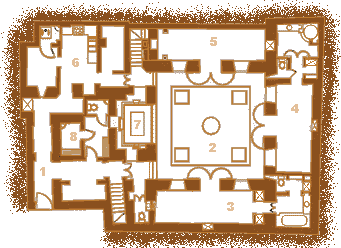samedi 15 juin 2013
The Bahia Palace
The Bahia Palace is a palace and a set of gardens located in Marrakech, Morocco. It was built in the late 19th century, intended to be the greatest palace of its time. The name means "brilliance". As in other buildings of the period in other countries, it was intended to capture the essence of the Islamic and Moroccan style. There is a 2 acre (8,000 m²) garden with rooms opening onto courtyards.
A riad
A riad (Arabic: رياض) is a traditional Moroccan house or palace with an interior garden or courtyard. The word riad comes from the Arabian term for garden, « ryad » The ancient Roman city of Volubilis provides a reference for the beginnings of riad architecture during the rule of the Idrisid DynastyAn important design concern was Islamic notions of privacy for women inside residential gardens.
The Menara gardens
The Menara gardens are gardens located to the west of Marrakech, Morocco, at the gates of the Atlas mountains. They were built in the 12th century (c. 1130) by the Almohad ruler Abd al-Mu'min.
The name menara derives from the pavillon with its small green pyramid roof (menzeh). The pavilion was built during the 16th century Saadi dynasty and renovated in 1869 by sultan Abderrahmane of Morocco, who used to stay here in summertime.
Marrakech Menara Airport is more than just an airport, it's a time machine. When you step outside our 21st century airport, you'll enter a city where classical traditions of the arts, crafts, music, and food are as vibrant today as they were centuries ago.
Direct flights connect Marrakech with cities throughout Europe, and from there to the world.
In 2010, the airport will serve over three million passengers. We sincerely hope you will be one of them.
The Koutoubia
The Koutoubia Mosque or Kutubiyya Mosque (Arabic: جامع الكتبية Arabic pronunciation: [jaːmiʕu‿lkutubijːa(h)]) is the largest mosque in Marrakech, Morocco. The mosque is also known by several other names, such as Jami' al-Kutubiyah, Kotoubia Mosque, Kutubiya Mosque, Kutubiyyin Mosque, and Mosque of the Booksellers. It is located in the southwest medina quarter of Marrakech.[1] The mosque is ornamented with curved windows, a band of ceramic inlay, pointed merlons, and decorative arches; it has a large plaza with gardens, and is floodlit at night.
Marrakesh
Marrakesh, or Marrakech ( Arabic: مراكش, Murrākuš) (pronounced Marra-kesh), is a major city in the northwest African nation of Morocco.
Marrakech is a fantastic city, it is also a symbol of Morocco. The streets of the old city of Marrakech have been too narrow to allow cars, and tourists searching for the "real" Morocco have turned the medieval structures of Marrakech into good business.
The most worthwhile tourist areas in Marrakech are inside a very small area, starting in the north with, continuing through the town square of Jamaa El Fna with its crowd of storytellers, musicians and the beautiful Koutoubia Mosque which is visible from practically anywhere in Marrakech.
vendredi 14 juin 2013
Types of tagines
A tagine is a unique type of ceramic or clay cookware that's popular in MOROCCO. The bottom is a wide, circular shallow dish used for both cooking and serving, while the top of the tagine is distinctively shaped into a rounded dome or cone.The word "tagine" also refers to the succulent dish which is slow-cooked inside the cooking vessel. Typically, a tagine is a rich stew of meat, chicken, or fish, and most often includes vegetables or fruit. Vegetables can also be cooked alone.
 |
raisins secs tajine |
 |
Fish tagine |
 |
| Tajine meat |
 |
| Meatballs tajine |
 |
Tajine with seven vegetables |
Moroccan Sahara
Tafilalt or Tafilet (Arabic: تافيلالت) is a region and the most important oasis of the Moroccan
Sahara; it is also considered one of the largest oases in the world, the oasis
is entirely located along the Ziz River.
The oasis is ten days' journey south of Fez, across the
Atlas Mountains. It is celebrated for its large and luscious dates, to the
successful cultivation of which, soon after the arrival of an ancestor (Al
Hassan Addakhil) of the reigning dynasty of Morocco (the Alaouite Dynasty)
around 1250, this dynasty owes its rise to power.
Since 1648 it has been the custom of Moroccan sultans to
despatch superfluous sons and daughters to Tafilalt. The inhabitants occupy
fortified villages (Ksar). In Ifli, the central portion, formerly existed the
town of Sijilmasa, founded by Miknasa Berbers in 757. It was on the direct
caravan route from the Niger to Tangier, and attained a considerable degree of
prosperity. It was destroyed, but its ruins still extend five miles along the
river bank.
Folk dance
The name Tafilalt is a Berber name with an uncertain
meaning. It is a relatively recent name, in use only since as late as the 16th
century. The current royal family of Morocco, the Filalis, have taken their
name from the region.
 |
| Dates |
The first European to visit Tafilalt in the modern era was
René Caillié (1828), the next Gerhard Rohlfs (1864). A later visit to the oasis
byWB Harris is described in his book Tafilet (London, 1895).
Inscription à :
Commentaires (Atom)













































